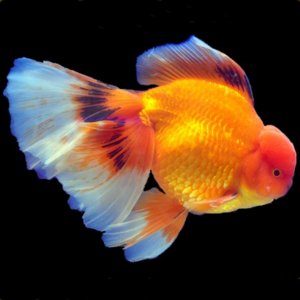The white dots are not white spot, Lymphocystis or any disease I have seen. It kind of looks like breeding spots but they normally occur on the gill cover not on the head, and only occur on male fish. There is a disease that affects cichlids called hole in the head disease but I have never heard of it affecting goldfish. I would do a big (75%) water change and gravel clean the substrate each day for a week and see if it helps.
The lack of appetite can be related to poor water quality (possibly ammonia) or an internal infection.
Is the fish eating anything?
Do they get any plant matter in their diet?
What does its poop look like?
--------------------
You don't want an anti-algae pad in the filter. Algicides are harmful to plants and fish and whilst the dots and lack of appetite are probably unrelated, you don't want algicides in the water. You can replace it with a sponge that is the same size or slightly bigger. Sponges get washed in a bucket of tank water each month and the sponge will last for years. The bucket of dirty water gets poured on the lawn or garden outside.
If you have an algae problem you can deal with it via light, live plants or water changes.
--------------------
Any idea what the ammonia level is in the water?
Any idea what the ingredients are in the medication you used?
What's a gravel sifter?
You want to use a gravel cleaner like the one in the following link (about half way down the page). Use it every week to keep the gravel clean. Do a 75% water change too because it will dilute things more effectively than small water changes.
Aquarium cleaning should take 30 minutes every two weeks. Learn how the professionals do it in 18 easy steps.

www.about-goldfish.com
--------------------
FIRST AID FOR FISH
Test the water for ammonia, nitrite, nitrate and pH. You have done most of this but there is no ammonia reading. The fish has a bit of excess mucous on its face and eyes and this can be caused by ammonia or other chemicals in the water.
Wipe the inside of the glass down with a clean fish sponge. This removes the biofilm on the glass and the biofilm will contain lots of harmful bacteria, fungus, protozoans and various other microscopic life forms.
Do a 75% water change and gravel clean the substrate every day for a week or until the problem is identified. The water changes and gravel cleaning will reduce the number of disease organisms in the water and provide a cleaner environment for the fish to recover in. It also removes a lot of the gunk and this means any medication can work on treating the fish instead of being wasted killing the pathogens in the gunk.
Make sure any new water is free of chlorine/ chloramine before it is added to the tank.
Clean the filter if it hasn't been done in the last 2 weeks. However, if the filter is less than 6 weeks old, do not clean it. Wash the filter materials/ media in a bucket of tank water and re-use the media. Tip the bucket of dirty water on the garden/ lawn. Cleaning the filter means less gunk and cleaner water with fewer pathogens so any medication (if needed) will work more effectively on the fish.
Increase surface turbulence/ aeration to maximise the dissolved oxygen in the water.


 I love that profile pic of the goldie
I love that profile pic of the goldie  looks like they are waving.
looks like they are waving.